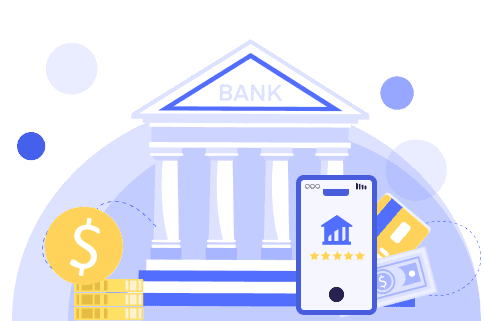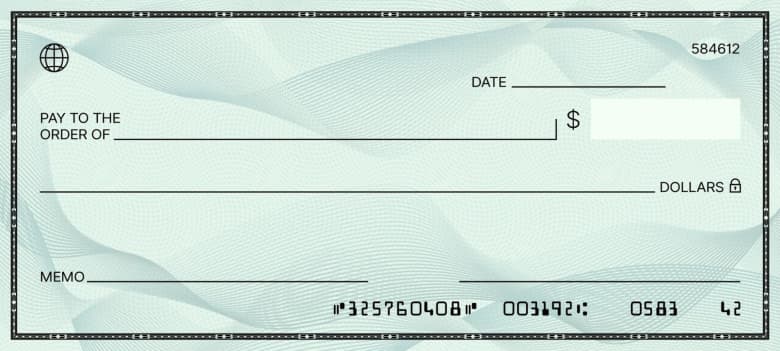A checking account is a safe and convenient place to keep your money that you can easily access for everyday purchases and bills. You can deposit funds into your checking account and then withdraw them using checks, a physical document instructing the bank to pay a certain amount to a designated person or business.
What Is a Checking Account?
Checking accounts are transactional bank accounts, used for needs like paying bills and receiving paychecks. You can also use checks, a document telling the bank to pay a certain amount to a person or business.

Updated: October 30, 2024
Advertising & Editorial Disclosure
How Checking Accounts Work
When you deposit money into a checking account, the bank holds the funds for you. You can access your funds in several ways: writing checks, using a debit card, setting up automatic transfers or withdrawing cash at a branch or ATM.
While checking accounts are not traditionally known for earning interest, some banks offer interest-bearing checking accounts. These accounts accrue interest on the balance, similar to a savings account. While you'll earn interest, it's usually lower than what you could get from a high-yield savings account or certificate of deposit.
There are several types of checking accounts designed to fit specific needs:
Basic Checking Accounts
These are straightforward accounts that offer unlimited transactions but typically do not earn interest.
Interest Checking Accounts
These accounts earn interest on your balance.
Student Checking Accounts
Many banks offer checking accounts specifically for students, with features like no monthly fees or minimum balance requirements.
Business Checking Accounts
These are designed for business use and come with features like the ability to deposit checks made out to the business.
Senior Checking Accounts
Some banks offer unique checking accounts for customers 65 and older. These accounts typically have discounted fees or special privileges compared to standard checking products.
Some checking accounts require a minimum balance to avoid monthly fees. The required amount can vary widely between banks and account types. Some banks waive the minimum balance requirement if you make a regular direct deposit into the account.
High-Yield Checking Accounts
While most standard checking accounts pay little or no interest, some banks and credit unions offer high-yield checking accounts with higher interest rates on balances. These accounts can allow you to earn much more interest than a regular checking account while still giving you full access to your funds.
Many financial institutions offer high-yield checking accounts, including traditional banks, credit unions and online banks. Interest rates on these accounts can range from around 1% to over 4% or more.
Why Checks Are Important
Checks provide a convenient method of payment, especially for larger amounts where carrying cash may not be practical. They are widely accepted by businesses, landlords, service providers and individuals. Furthermore, checks provide a paper trail, making it easier to track your spending and maintain accurate financial records.

Example of a blank check
When using checks, ensure that all the necessary details are correctly filled out, including the date, payee’s name and the amount in both words and figures. Always sign your checks, and never pre-sign blank checks. Even if it's convenient, a pre-signed blank check falling into the wrong hands can lead to forgery and theft from your account.
Be aware that some stores may require identification when accepting personal checks to prevent fraud, so it's best to keep your ID handy when making transactions.
Consequences of Bounced Checks
A bounced check, also known as a ‘nonsufficient funds’ or NSF check, is a check that cannot be processed because the account holder has insufficient funds. Bouncing a check can have several negative consequences:
- Fees: Both your and the recipient’s banks may charge NSF fees, which can add up quickly.
- Credit Impact: If unpaid, bounced check fees could be sent to collections, potentially damaging your credit score.
- Legal Consequences: Depending on your location and the amount of the check, bouncing a check could potentially have legal repercussions.
- Banking Consequences: Some banks may close accounts with too many bounced checks or report the account holder to a consumer reporting agency, which could make it harder to open bank accounts in the future.
Avoid bouncing checks by regularly reviewing your account statements and keeping track of any checks you've written that still need to be cashed by the recipient.
Debit Cards as a Feature of Checking Accounts
Debit cards are a common feature of checking accounts, providing a convenient and secure method of accessing your funds.
While debit cards are typically associated with checking accounts, they are not exclusive to them. Some savings accounts and money market accounts may also offer debit cards. Checking accounts are most commonly used for daily transactions, making them the primary account type associated with debit cards.
Debit cards offer several advantages. They provide immediate access to your funds for in-store or online purchases or cash withdrawals at ATMs. They are safer to carry than cash and are accepted at millions of locations worldwide.
When using a debit card, the funds are directly withdrawn from your linked checking account. To avoid potential overdraft fees, make sure that you have sufficient funds in your account to cover your transactions. Fees can also apply for specific transactions, such as using an ATM outside your bank’s network.
Common Uses for Checking Accounts
Checking accounts are designed for everyday money management, including:
Daily Transactions
Checking accounts are ideal for daily transactions such as grocery shopping, dining out or online purchases. The associated debit card makes it easy to pay directly from your account, both in-store and online.
Bill Payments
Many people use their checking accounts to set up automatic payments for regular bills such as utilities, rent or mortgage payments. This ensures timely payments and helps avoid late fees. It also reduces paper waste.
Direct Deposit
Most employers offer the option to set up direct deposit for paychecks, which is typically done through a checking account. This provides a quick, convenient, and secure way to receive your salary.
Money Transfers
Checking accounts allow for easy money transfers, whether you’re sending money to a friend, transferring to a savings account or paying a bill.
Common ways to deposit money into a checking account include:
- Direct deposit of paychecks or other income sources
- Mobile check deposit using your bank's app to snap photos of checks
- Cash or check deposits made at an ATM
- In-person deposits made with a bank teller
- Electronic transfers like ACH payments from other accounts
- Incoming domestic or international wire transfers
Regular deposits into your checking account ensure you have sufficient funds for withdrawals and to keep the account active and open.
Checking Account vs. Savings Account
While checking accounts and savings accounts both allow you to securely hold your money at a bank, they serve different purposes.
Checking Account | Savings Account |
|---|---|
Allows unlimited deposits and withdrawals | Typically limited to six withdrawals or transfers per month |
Facilitates daily spending via debit cards, checks and online bill pay | Not designed for daily transactions |
Typically pays minimal or no interest | Pays higher interest rates compared to checking accounts |
No limits on accessing your money | Withdrawals may be subject to fees after exceeding the monthly withdrawal limit |
Pros and Cons of Checking Accounts
As with any financial product, checking accounts come with their own set of benefits and drawbacks.
Pros of Checking Accounts
Ease of Access
Checking accounts offer easy access to your money through checks, debit cards and ATMs. This makes them ideal for daily transactions, unlike other accounts, such as CDs or savings accounts, which may have withdrawal restrictions.
Direct Deposit
Most employers offer direct deposit for paychecks, which is typically set up through a checking account. This provides a quick, convenient and secure way to receive your salary.
Bill Payments and Money Transfers
Checking accounts allow for automatic bill payments and easy money transfers, making it simple to manage your finances.
Protection
Funds in checking accounts are insured by the FDIC (Federal Deposit Insurance Corporation) or NCUA (National Credit Union Administration) up to $250,000, protecting against bank failure.
Cons of Checking Accounts
Lower Interest Rates
Checking accounts usually have lower interest rates than savings accounts or CDs. This means you’re not earning as much on your balance as you could be with other types of accounts.
Fees
Some checking accounts come with monthly maintenance fees, minimum balance requirements or overdraft fees. While these can often be waived with direct deposit or maintaining a minimum balance, they can add up if not managed properly.
Overdraft Risk
If you’re not careful, it’s easy to overdraw a checking account, which can result in hefty fees.
Lack of Investment Growth
Money in a checking account isn’t invested, so it doesn’t have the growth potential you might see with other financial products like a brokerage account or retirement fund.
Common Checking Account Fees
Checking accounts can come with a variety of fees. Here are some of the most common ones you may see:
Overdraft Fees
If you spend more than the available balance in your checking account, the bank may cover the difference and charge you an overdraft fee. These fees can be high, so it's important to keep track of your balance.
Monthly Service Fees
Some banks charge a monthly fee for maintaining a checking account. However, these fees can often be waived if you meet certain requirements, such as maintaining a minimum balance or setting up direct deposit.
Bounced Check Fees
If you write a check that exceeds your account balance and the bank does not cover the overdraft, you may be charged a bounced check fee.
Stop Payment Fees
If you need to stop a payment after issuing a check, the bank may charge a stop payment fee.
Check Ordering Fees
While many banks provide an initial set of checks for free, they may charge a fee for additional orders.
How to Choose the Best Checking Account
Here are some basic steps to consider when choosing the best checking account for your situation:
- 1
Identify Your Needs
Consider how you plan to use your checking account. Do you make a lot of transactions? Do you prefer to use checks, debit cards or digital payments?
- 2
Consider the Fees
Be aware of any fees associated with the checking account, such as monthly maintenance fees, overdraft fees or ATM fees. Some banks waive these fees if you meet certain criteria, such as maintaining a minimum balance or setting up direct deposit.
- 3
Look at Accessibility
Consider how easy it is to access your funds. Does the bank have ATMs near your home or work? Do they offer online and mobile banking?
- 4
Evaluate Customer Service
Good customer service can be very valuable. Consider whether the bank offers convenient customer service options such as online chat, phone support and in-person service.
- 5
Interest Rates
While checking accounts are not known for high interest rates, some do offer interest. If earning interest on your checking account balance is important, compare the rates different banks offer.
How to Open a Checking Account
Once you’ve chosen a bank and a checking account that suits your needs, the process to open an account is typically straightforward:
- 1
Gather Your Information
You’ll need to provide personal information, such as your name, address and Social Security number. You may also need to provide a valid form of identification, such as a driver’s license or passport.
- 2
Apply Online or In Person
Many banks allow you to open a checking account online, but you can also visit a branch in person. You’ll need to fill out an application with your personal information.
- 3
Make an Initial Deposit
Some banks require an initial deposit to open a checking account. The amount can vary widely, so check with the bank to understand their requirements.
- 4
Set Up Features
Once your account is open, you can set up any features you want to use, such as direct deposit, online bill pay or mobile check deposit.
When opening a new checking account, you'll need to provide information to facilitate moving money from your existing account at another bank. This allows you to transfer funds to start your new account. If funding the new account from an old checking account, you'll need both the routing number and account number for that previous account.
Once you have your new checking account set up, it's a good idea to take advantage of its various features and capabilities to streamline your finances. Start by enrolling in direct deposit so your paycheck or other income can automatically flow into the account.
Also, explore online bill pay and enroll in any available recurring payments such as rent, utilities, subscriptions and loan payments. This can help you avoid missing payments and sometimes even earn you a discount.
Checking Account Bonuses
Many banks offer cash bonuses to attract new checking account customers, also known as rewards checking accounts. These bonuses typically require you to open a new checking account and meet certain requirements like setting up direct deposit or maintaining a minimum balance for a set period.
Checking account bonuses can range from $100 to $500 or more at some banks. While a bonus is nice, be sure to also look at the overall fees, requirements and account terms rather than just chasing the biggest bonus. Keep in mind that bonuses are subject to tax.
FAQ About Checking Accounts
MoneyGeek has compiled answers to some of your frequently asked questions about checking accounts.
How do you open a checking account?
To open a checking account, you generally need to provide your contact information, date of birth, a government-issued photo ID such as a driver’s license or passport, Social Security number or Individual Taxpayer Identification Number (ITIN) and proof of address. Most banks require an initial deposit, which can range from $5 to $100.
What’s the difference between a checking and a savings account?
Checking accounts are typically used for daily spending, whereas savings accounts are mainly used for accumulating funds over time. Checking accounts are more suitable for frequent transactions like paying bills, buying goods like groceries and withdrawing money from ATMs.
What information do you need to open a checking account?
The information you need to open a checking account includes your contact information (name, address, phone number, etc.), date of birth, a government-issued photo ID such as a driver’s license or passport, Social Security number or Individual Taxpayer Identification Number (ITIN), proof of address (such as a mortgage statement, rental agreement or utility bill) and an opening deposit.
Can you overdraft on a checking account?
Yes, you can overdraft on a checking account. Overdraft protection is a feature provided by many banks and credit unions. It permits customers to withdraw more than the balance in their checking accounts, typically for a fee. With overdraft protection, transactions are processed even if there isn’t enough money in the account to cover the expenses.
How much money should you keep in your checking account?
As a general guideline, it's a good idea to maintain a couple of months’ worth of living expenses in your checking account. This should allow you to manage regular bills while providing a buffer to protect from unexpected expenses.
How do you close a checking account?
To close a checking account, you should first open a new bank account and transfer any direct deposits or automatic payments to the new account. Then, ensure all transactions have cleared in the old account. Once everything is settled, you can request to close the account with your bank.
How old do you have to be to open a bank account?
Generally, a person must be at least 18 to open a bank account on their own. However, the age requirement can vary by bank. Most banks allow minors to open a bank account with a parent or guardian as a co-owner.
Is a checking account good for emergency funds?
While a checking account provides easy access to funds, it’s not the best place for an emergency fund due to its low interest rates. An emergency fund is better placed in a high-yield savings account where it can earn more interest.
How often should you review your checking account statement?
It’s a good habit to check your checking account regularly. If you frequently use your debit card or make a lot of transactions, you should review your checking account online at least once a week.
About Alvin Yam, CFP

Alvin Yam is a certified financial planner (CFP) with over 15 years of experience working with individuals and corporations. Before founding Paraiba Wealth Management, he was a director at HSBC and a financial consultant at Charles Schwab. Yam is MoneyGeek's expert consultant on wealth management and personal banking.
Yam earned his bachelor's degree in political science from the University of California, San Diego, and his Master of Business Administration from Loyola Marymount University.
sources
- Federal Deposit Insurance Corporation. "Deposit Insurance FAQs." Accessed October 30, 2024.
The content on this page is accurate as of the posting/last updated date; however, some of the rates mentioned may have changed. We recommend visiting the lender's website for the most up-to-date information available.
Editorial Disclosure: Opinions, reviews, analyses and recommendations are the author’s alone and have not been reviewed, endorsed or approved by any bank, lender or other entity. Learn more about
our editorial policies and expert editorial team.









